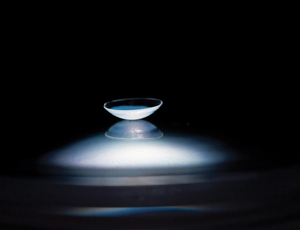|
"Today, contact lenses are promising to become far more than simply devices for refractive correction."
|
Monitoring Glucose in Diabetics
One of the most promising new projects has been undertaken by researchers at the University of Washington in partnership with Google. They’re developing a contact lens that, if all goes according to plan, will be able to measure glucose levels in a person’s tears, thus providing a way to monitoring systemic blood glucose levels. A spokesperson for Google says that their goal is to create a lens that also provides refractive correction, so that the product will help the most people. Obviously, such a lens would be a huge benefit to people with diabetes, many of whom currently have to prick their fingers and draw blood repeatedly to track their glucose levels.
In the prototypes, a number of miniaturized electronic components have been embedded in the periphery of the lens, outside the patient’s line of vision. The electronics in the lens are powered by radio waves from a mobile device worn by the patient, rather than an internal power supply. The lenses are being made of standard materials such as hydrogels; a pinhole in the lens material will allow tear fluid to directly contact the glucose sensor. Current prototypes can take a glucose level reading once every second; the data will be transmitted to the patient’s cellphone (and possibly the doctor’s office as well). Dangerously high readings may trigger an alarm, and the developers are also working on the possibility of integrating tiny LED lights into the lenses that would illuminate when glucose levels become too high.
|
Long-term Medication Delivery
Given the fact that contact lenses absorb and release fluids, one of the “holy grails” in contact lens research has been the development of a lens that can elute a drug slowly over a long period of time. Joseph B. Ciolino, MD, a physician-scientist in the Cornea Service at Massachusetts General Hospital in Boston, and Daniel S. Kohane, MD, PhD, from Boston’s Children’s Hospital, have developed prototypes of just such a lens. Their design incorporates a very thin drug polymer film sandwiched between layers made of standard contact lens hydrogel. Unlike a standard contact lens, which tends to release any drug it’s soaked in within two hours or less, their prototype, used in animal models, releases medication fairly evenly over a period of 30 days or more. (For more on the technology used in this lens, see Long-term Noninvasive Topical Drug Delivery in the January 2014 issue of Review.)
“Right now we’re focusing on delivering latanoprost and anti-inflammatory medications such as dexamethasone,” says Dr. Ciolino. “We’re also interested in using the lens to deliver antibiotics. If a drug-eluting contact or a corneal ulcer wouldn’t have to take drops on an hourly basis. A contact lens like this might even be able to treat dry eye or ocular allergies. It’s also possible that it could deliver more than one medication. For example, following cataract surgery the surgeon could place one of these contact lenses on the eye, where it would elute antibiotic and steroid for a week. At the one-week follow-up, the surgeon would simply remove it.”
Dr. Ciolino sees a number of advantages to this system.
“First, there’s decreased frequency of administration,” he says. “Second, the lens can provide positive reinforcement for compliance by correcting the patient’s myopia or hyperopia. Third, because it doesn’t involve drops, there is far less wasted drug. Fourth, we can potentially release medications that are not water-soluble—drugs that are difficult to administer using drops.” Dr. Ciolino adds that some other long-term delivery options under development, such as intraocular injections of microparticles, may be less appealing to patients.
Dr. Ciolino says his team hopes to soon begin human trials of the lens. “Contact lenses are something that everyone can relate to,” he adds. “They capture the imagination of the public.”
REVIEW






